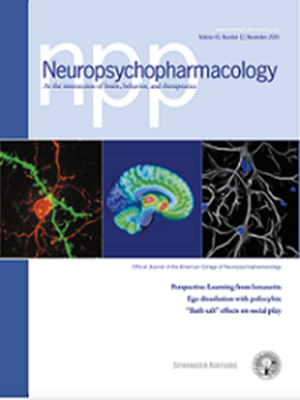在一项针对自闭症的随机临床试验中,随机森林和 Shapley Additive exPlanations 预测了催产素对涉及显著性和感觉运动处理的大脑功能网络的定向影响。
IF 6.6
1区 医学
Q1 NEUROSCIENCES
引用次数: 0
摘要
鼻内催产素(in - oxt)在挽救自闭症谱系障碍(ASD)患者的社交缺陷方面显示出一些希望,但在长期试验中也存在一些不一致之处。我们进行了一项目标参与研究,以研究不同剂量的in - oxt对ASD脑静息状态功能连接(rsFC)的确切影响。我们采用双盲、安慰剂对照、受试者内设计,研究了不同剂量的in- oxt (0 IU、8 IU、24 IU、48 IU)对rsFC的影响,其中30名成年男性ASD患者和17名接受安慰剂的神经典型对照组(NT)。随机森林分析用于将个体划分为ASD或NT。计算shape Additive解释值,根据对ASD缺陷的贡献水平对脑功能网络进行排序,并评估IN-OXT剂量效应。该模型预测ASD诊断的AUC为94%。突出/共情和视觉网络之间的低连通性,奖励和感觉运动网络以及心理理论网络之间的超连通性是ASD缺陷的最强预测因子。IN-OXT在挽救上述两种缺陷方面具有剂量依赖性。总体而言,48 IU剂量更有效,24 IU剂量对DNA OXT受体甲基化程度较低和临床症状严重程度较低的患者更有效。高剂量的OXT可能需要增强共情反应,并且需要较少支持和保留OXT系统的ASD个体可能从OXT治疗中获益最多。在OXT研究中应用机器学习方法可以提供数据驱动的无偏结果,为未来的临床试验提供信息。本文章由计算机程序翻译,如有差异,请以英文原文为准。

Random forest and Shapley Additive exPlanations predict oxytocin targeted effects on brain functional networks involved in salience and sensorimotor processing, in a randomized clinical trial in autism
Intranasal oxytocin (IN-OXT) has shown some promises in rescuing social deficits in autism spectrum disorder (ASD) as well as some inconsistencies in long-term trials. We conducted a target engagement study to study the precise effects of different doses of IN-OXT on brain resting-state functional connectivity (rsFC) in ASD. We examined the effects of varying doses of IN-OXT (0 IU, 8 IU, 24 IU, 48 IU) on rsFC in a double-blind, placebo-controlled, within-subject design in 30 male adults with ASD and 17 neurotypical controls (NT) receiving placebo. Random forest analysis was used to classify individuals as ASD or NT. Shapely Additive explanations values were calculated to rank brain functional networks by level of contribution to ASD deficits and to evaluate IN-OXT dose effects. The model predicted ASD diagnosis with an AUC of 94%. Hypoconnectivity between salience/empathy and visual networks, and hyperconnectivity between reward and sensorimotor networks and theory of mind networks were among the strongest predictors of ASD deficits. IN-OXT had a dose-dependent effect on rescuing both deficits described above. Overall, 48 IU dose was more effective, and 24 IU dose was more effective in those who have lower DNA OXT receptor methylation and lower severity of clinical symptoms. Higher doses of OXT might be necessary to enhance empathic responses, and ASD individuals with less support needs and with a preserved OXT system might benefit most from OXT treatment. Applying machine learning approaches in OXT research can provide data-driven unbiased results that can inform future clinical trials.
求助全文
通过发布文献求助,成功后即可免费获取论文全文。
去求助
来源期刊

Neuropsychopharmacology
医学-精神病学
CiteScore
15.00
自引率
2.60%
发文量
240
审稿时长
2 months
期刊介绍:
Neuropsychopharmacology is a reputable international scientific journal that serves as the official publication of the American College of Neuropsychopharmacology (ACNP). The journal's primary focus is on research that enhances our knowledge of the brain and behavior, with a particular emphasis on the molecular, cellular, physiological, and psychological aspects of substances that affect the central nervous system (CNS). It also aims to identify new molecular targets for the development of future drugs.
The journal prioritizes original research reports, but it also welcomes mini-reviews and perspectives, which are often solicited by the editorial office. These types of articles provide valuable insights and syntheses of current research trends and future directions in the field of neuroscience and pharmacology.
 求助内容:
求助内容: 应助结果提醒方式:
应助结果提醒方式:


